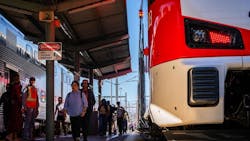Caltrain’s electric fleet more efficient than expected
Caltrain is reporting that its new electric trains are outperforming the agency’s original projections. Announced during the monthly board of directors meeting, the agency reported that regenerative braking on the new trains is generating and sending back to the electric grid approximately 23 percent of the energy consumed by the system.
Originally estimated to cost approximately $19.5 million annually, Caltrain’s electricity use since the launch of electric service averages 207 MWh on weekdays and 175 MWh on weekends, revising cost estimates to $16.5 million. With the agency expecting approximately $6 million annually in energy credits from the California Air Resources Board’s Low Carbon Fuel Standard Program, Caltrain says the first year of electric service will have lower fuel costs than the previous diesel service. Currently, Caltrain is providing that power to the grid free of charge, as there is no legal requirement for the agency to be reimbursed for the energy generated.
Regenerative braking works by driving an electric motor in reverse to recapture energy rather than losing it as heat during braking. Caltrain’s fleet is designed to return that power to the Overhead Contact System, which feeds it to the nearest traction power facility. From there, it can be used to power other trains on the system or returned to the grid.
“Caltrain is running its service on 100 percent renewable energy and is returning nearly a quarter of that energy to the grid,” said Caltrain Executive Director Michelle Bouchard. “The new electric fleet is delivering on its promise of state-of-the-art service, living up to our mission of providing sustainable transportation that enhances quality of life for everyone.”
